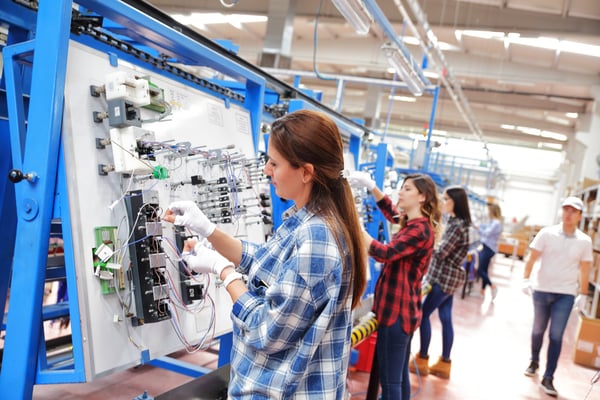How’s the Electronic Component Shortage Looking in 2019 so Far?
Two things are fairly certain about the current electronic component shortage: It’ll end, and it’ll someday return.

It’s time for your organization to begin production of a new electronic device. For one reason or another, you’re in no position to take care of the work in-house. This means that you need to find a good partner to outsource the effort.
But, should you stick with your customary offshore partners, or is there a better option? Is there more to the offshoring/reshoring debate than just, “Who’s got the cheaper labor?”
Reshoring your electronics manufacturing is more viable than it’s been in decades. Here are some key questions for you to consider when it comes to outsourcing electronics manufacturing in 2021 and beyond.
Onshoring electronics manufacturing has become a more frequent topic of discussion since tariffs and the coronavirus pandemic rocked the industry in 2019 and 2020. Advantages of onshore electronics manufacturing include:
However, the camp against onshoring electronics manufacturing -- or any U.S. manufacturing for that matter -- frequently touts the following disadvantages:
But, when it really comes down to it, are these factors really that big of a deal? Not really. If COVID-19 has shown manufacturers anything, it’s that offshore supply chains are extremely fragile. Bringing electronics manufacturing back to the United States gives manufacturers the opportunity to explore new supply chains.
Naturally, the pros and cons of offshore electronics manufacturing are opposites of onshore. It’s still worth going into a bit more detail for the sake of clarity.
Obviously the largest advantage of shoving the work offshore is that the material supply chain is usually located in Asia.
Pulling back production to the U.S. decreases the chances of extended disruptions to supply chains. Plus, it makes obtaining raw materials easier, even though they might be a bit more expensive.
One of the key disadvantages to continued offshoring is the danger to intellectual property. When product designs are sent overseas, there’s no guarantee that they’ll stay secret, and you run the risk of knock-off products becoming legitimate competition.
Reshoring is certainly a viable option for electronics manufacturers.
There’s less risk of intellectual property theft because of tighter privacy and patent laws. Not to mention all the technological infrastructure will be easily accessible since it won’t be overseas.
Plus, bringing production back home gives manufacturers the ability to tap into local supply chains and decrease lead times.
While the component supply chain might be located overseas, shipping materials is smarter than shipping a finished product. Once factories have the raw materials they need, it’s nearly a straight shot to consumers from there. There’s no need to wait for shipment of finished products that could be damaged or otherwise not up to quality standards. When the manufacturing is done on U.S. soil, it’s easier to ensure a high-quality finished product.
The COVID-19 pandemic has clearly disrupted supply chains and manufacturing operations across the globe. Most factories in China were shut down by January 2020, halting production of high-profile electronics like Apple’s iPhone.
Relying on a distant manufacturer during uncertain times makes onshoring and reshoring more attractive to companies that cannot afford delays in production.
Because of pandemic-related supply chain disruptions, American companies have been debating the outsourcing vs. onshoring issue with more fervor.
The COVID-19 pandemic created shortages across the economy, whether for consumer goods like hand sanitizer and food items, or for critical components for manufacturing.
The longer the supply chain, the more kinks might arise in that process. Laws change, tariffs increase, shipping costs shoot through the roof. Pandemic-related problems like closed borders and mandatory quarantine only add to the stress.
When a manufacturing supply chain is shorter, there’s less room for unexpected problems. As we saw with COVID-19, companies that had shorter, closer-to-home supply chains could get what they needed faster, whereas companies with long supply chains struggled to stay afloat.
Moving forward, companies should move their supply chains closer to home to minimize undue risk. Disruptions will happen -- the trick is taking the right precautions to prepare for them.
While reshoring is becoming more popular, there are potential cybersecurity risks associated with moving production back stateside. The transition phase might leave critical company secrets vulnerable and result in the theft of intellectual property.
“Making the shift to onshore production will lower security risk in the end but have a short-term risk due to bringing everything back into the U.S.,” Coalfire offensive security director Joseph Neumann said in this TechRepublic report.
IP protection is also more difficult overseas, especially in China, whose views on internet privacy and patent protection are vastly different than the United States’.
When getting started with reshoring, it’s crucial that companies bolster their cybersecurity to minimize risk.
If your organization is preparing to outsource a new electronics project, you and fellow stakeholders may still be on the fence about whether to work with an onshore or offshore manufacturer. Remember that while onshoring may require added up-front costs and cybersecurity measures, it’s still a safer long-term solution than relying on offshore suppliers.
To learn more about the diverse capabilities of American electronics manufacturers, take a look at our free e-book.

Two things are fairly certain about the current electronic component shortage: It’ll end, and it’ll someday return.

If there's anything certain in the U.S.-China tariffs staredown, it's uncertainty.
.jpg)
NOTE: This article was updated on July 3, 2025 to reflect recent information regarding tariffs.